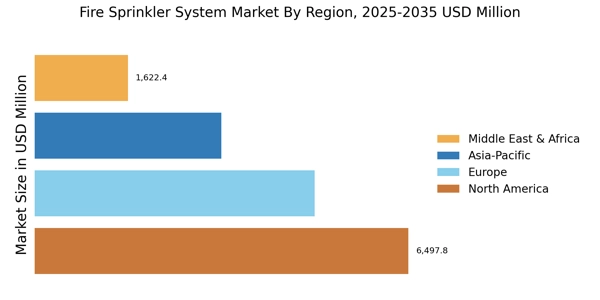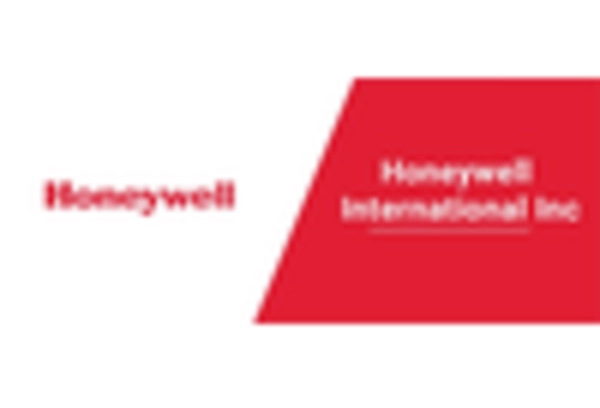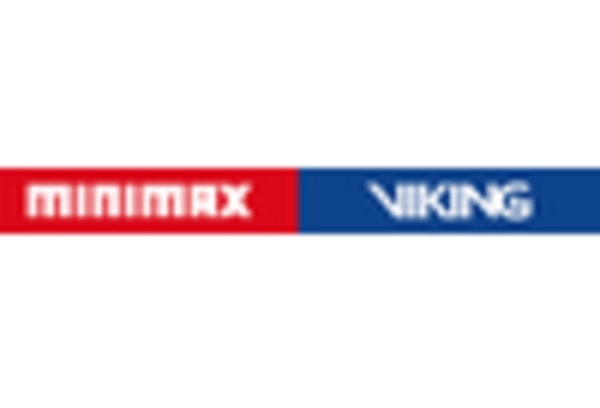Growth in Construction Activities
The ongoing growth in construction activities across various sectors is anticipated to be a vital driver for the Fire Sprinkler System Market. As new residential, commercial, and industrial projects emerge, the demand for fire safety solutions, including sprinkler systems, is likely to increase. Data indicates that the construction industry is projected to grow at a rate of approximately 5% annually, which correlates with the rising need for fire protection measures. This growth presents a substantial opportunity for manufacturers and suppliers within the Fire Sprinkler System Market, as they seek to meet the demands of new constructions that require compliant fire safety systems.
Increased Awareness of Fire Safety
The rising awareness of fire safety among businesses and homeowners appears to be a crucial driver for the Fire Sprinkler System Market. As incidents of fire-related disasters continue to garner media attention, stakeholders are increasingly prioritizing fire prevention measures. This heightened awareness is reflected in the growing demand for fire sprinkler systems, which are recognized as effective tools for mitigating fire risks. According to recent data, the fire protection systems market, which includes fire sprinklers, is projected to reach a valuation of approximately 80 billion by 2026. This trend suggests that as awareness increases, so too does the investment in fire safety solutions, thereby propelling the Fire Sprinkler System Market forward.
Stringent Building Codes and Regulations
The implementation of stringent building codes and regulations is likely to serve as a significant driver for the Fire Sprinkler System Market. Many regions have adopted more rigorous fire safety standards, mandating the installation of fire sprinkler systems in both residential and commercial buildings. These regulations are often influenced by historical fire incidents that have led to loss of life and property. For instance, the National Fire Protection Association has established guidelines that many jurisdictions follow, which has resulted in a marked increase in compliance-driven installations. This regulatory environment not only enhances safety but also stimulates market growth, as compliance necessitates investment in fire sprinkler systems.
Rising Insurance Premiums and Liability Concerns
Rising insurance premiums and liability concerns are emerging as influential factors driving the Fire Sprinkler System Market. As insurance companies increasingly recognize the value of fire protection systems in reducing risk, they may offer incentives for property owners to install fire sprinklers. This trend is particularly evident in high-risk industries, where the cost of fire-related claims can be substantial. Consequently, property owners are motivated to invest in fire sprinkler systems to mitigate potential liabilities and lower insurance costs. This dynamic not only enhances safety but also contributes to the overall growth of the Fire Sprinkler System Market.
Technological Innovations in Fire Sprinkler Systems
Technological innovations are transforming the Fire Sprinkler System Market, making systems more efficient and effective. Advancements such as smart sprinkler systems, which integrate with building management systems, are gaining traction. These innovations allow for real-time monitoring and automated responses to fire incidents, thereby enhancing safety measures. The market for smart fire protection systems is expected to grow significantly, with estimates suggesting a compound annual growth rate of over 10% in the coming years. This technological evolution not only improves the functionality of fire sprinkler systems but also appeals to a broader range of consumers, thereby driving market expansion.

















Leave a Comment